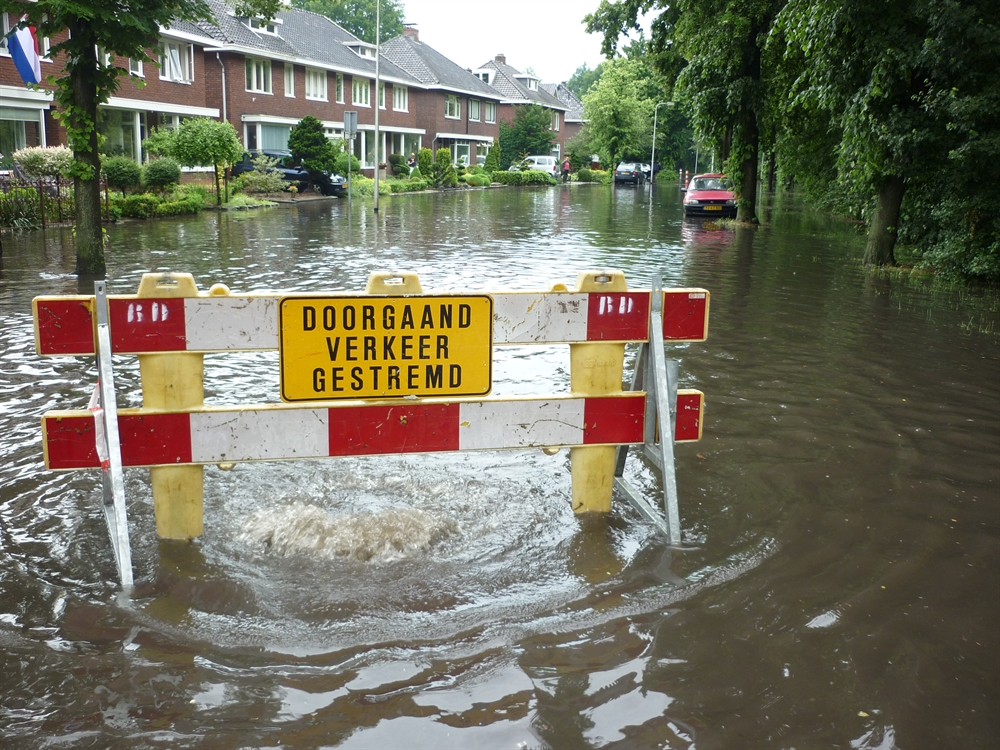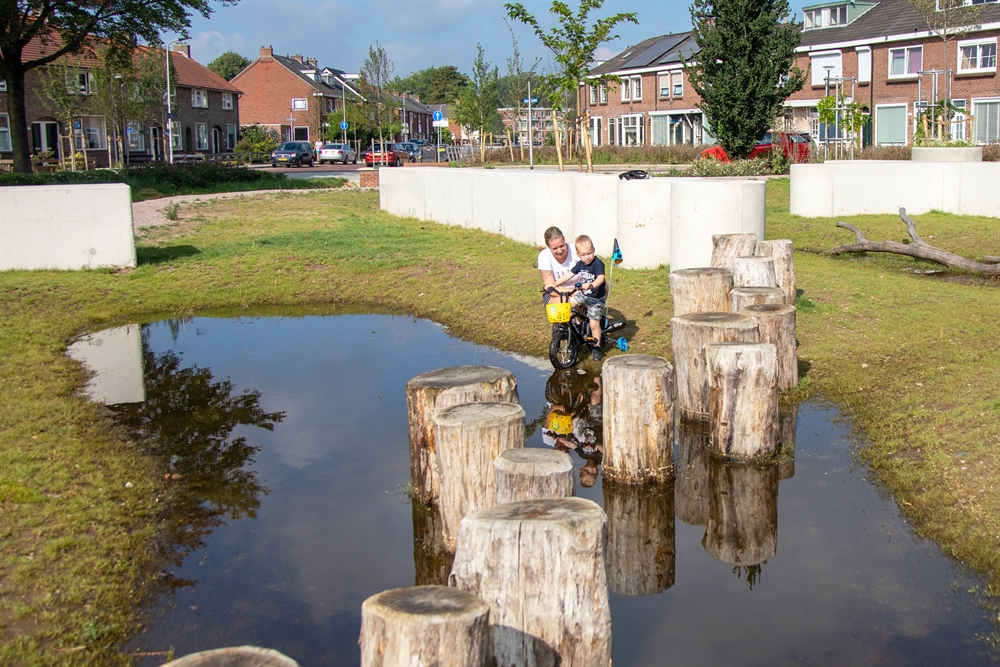Climate talks in Enschede: online dialogues on climate-proofing the city
For several years, the municipality of Enschede has been preparing the living environment for the consequences of more extreme weather. On account of its major differences in elevation, Enschede is prone to waterlogging. Furthermore, Enschede also appears to be prone to drought, and due to the large proportion of pavement, to heat as well. In 2019, the vulnerabilities of the municipality were mapped out in a climate stress test. In the autumn of 2020, the municipality conducted several online climate dialogues, under the auspices of Arcadis consultants.
What was the object of the dialogues?
With the climate dialogues, Enschede intended to achieve the following goals:
- Raising awareness among the participants regarding the changing climate and its impact on Enschede, and demonstrating ways in which individual parties can take measures to adapt their environment;
- Establishing the risks that participants are / are not willing to take. Where is the cut-off line?
- Retrieving input for the formulation of building blocks for the Climate Adaptation Strategy on which the municipality is currently working and which is scheduled to be published in June of 2021.

What approach has Enschede adopted?
In October and November of 2020, the municipality conducted six climate dialogues with several target groups. In December, another two were organised for municipal staff, followed by a dialogue with several municipal councillors in February of 2021. In addition, a survey was held among more than 1500 local residents, featuring questions on climate change and on the acceptance of risks. The paragraphs below outline the dialogues conducted in October and November.
- Climate talk with students and educational establishments: this dialogue was held during the Sustainability Week organised by the University of Twente, Saxion University of Applied Sciences, and Twente Regional Training Centre. Via the “Climate Impact Game”, the municipality entered into a dialogue with students and teachers. Playing this game together raised participants’ awareness of the impact of climate change. It also provided them with leads to discuss various interests, wishes, and opportunities.
- Dialogue within the municipality: officials involved in several domains entered into a debate on the municipal role in climate adaptation. They discussed responsibilities, potential strategies, and solutions. They also reviewed the risks that would / would not be acceptable and explored options for integrating adaptation measures into their own field of work.
- Area dialogue regarding industrial estates and shopping areas: the municipality set up a dialogue with business owners and other stakeholders on industrial estates and in shopping areas. How is extreme weather impacting these areas? For example, what does it entail for the health of the staff working there? Is it keeping customers away more frequently? What does it entail for the business process? And what opportunities can be identified for climate adaptation?
- Area dialogue regarding green environments: this dialogue was held with horticulturists, managers of parks and recreation areas, nature organisations, and terrain managers of large organisations. With them, the municipality discussed the impact of extreme weather on greenery within and outside the urban area. The goal was to raise awareness of such impact and to identify the risks. The dialogue mainly focused on how greenery can foster climate adaptation.
- Sector dialogue regarding real estate: this dialogue with real estate parties focused on the impact of extreme weather on and around buildings. It was intended to raise awareness and to collectively review an adaptation strategy and collect solutions. The participants included housing corporations, educational establishments, research institutes, and tenants’ associations.
- Area dialogue regarding residential areas: in this dialogue, the municipality contacted neighbourhood councils of urban and rural neighbourhoods. The dialogue was intended to raise awareness and identify the acceptance of climate risks. Furthermore, the councils shared the concerns and interests of local residents. Finally, the participants took the first step towards setting down ambition levels and solution strategies for an adaptation strategy at the neighbourhood level.
Participant of real estate sector dialogue: ‘Very good session. I actually intended to participate for only a little while, but I became completely engrossed.’
What results have the dialogues produced?
The dialogues have generated insights regarding the acceptance limits for several risks related to waterlogging, heat, and drought. The municipality can utilise those insights to make choices regarding adaptation measures. Furthermore, the dialogues have generated several building blocks for the strategy that will be presented this year:
- Creating awareness: (even) more attention will be paid to raising awareness of climate adaptation, both within the municipal organisation and among residents and other parties;
- Collaboration: the municipality intends to expand its collaboration with private parties, e.g., NGOs, local residents, and entrepreneurs;
- Embedding: the municipality intends to embed climate adaptation in its vision, policy, and working processes;
- Integrated approach: a neighbourhood-oriented and integrated approach will ensure the consideration of climate adaptation in redevelopment, maintenance, and new construction projects at the earliest possible stage;
- Learning by doing: the municipality will adopt a “learning by doing” approach by using best practices as an example for owners of private properties.
Participant of the dialogue within the municipality: ‘Participating in the Climate Talk was interesting and fun. Now that physical meetings are out, this approach worked quite well in keeping the meeting lively and dynamic.’

Lessons to be learned
The dialogues have taught the municipality of Enschede a great deal:
- It is not easy to get people, and especially entrepreneurs, to give up 2.5 hours of their time to attend an online meeting set up by the municipality;
- However, during the meetings, those 2.5 hours flew by, according to the participants. Each meeting started with a plenary session to create awareness, followed by an interactive session in small groups. This structure worked very well;
- The Mentimeter and Mural tools provided good support. Mentimeter worked best in terms of having people vote: it fired their imagination more than a Mural template. However, Mural proved ideal for the presentation of the final results in a risk matrix;
- The enthusiastic response to the first internal climate dialogue prompted the municipality to organise another two internal dialogues, which involved a total of 75 municipal staff: an overwhelming participation;
- The internal climate dialogues have been particularly effective in raising awareness. For example, the Traffic department recently invited climate adaptation staff to provide advice regarding water storage in road redevelopment projects. Before that, such advice was rarely sought.
Ergo, these dialogues have planted seeds! Now it is a matter of allowing these seeds to grow into a deeply rooted tree that will not disappear from the landscape.
Contact person
Lies Rubingh
Gemeente Enschede
l.rubingh@enschede.nl
